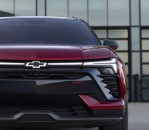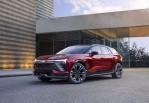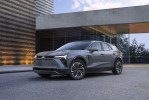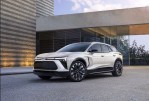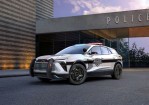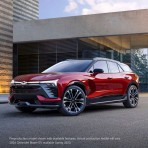Body style: SUV (Sports Utility Vehicle)
Segment: Large SUV
Infotainment: ![]() Apple CarPlay
Apple CarPlay ![]() Android Auto
Android Auto
Production years: 2022, 2023, 2024
 42 Photos
42 PhotosEven though it shares its name with the ICE-powered Blazer, the EV version was actually built on a different platform, and that helped it compete against its main rivals in the compact-SUV segment.
GM was one of the first major automakers to produce a fully-functional EV, the GM EV1, in 1996. But soon after that, it retracted and scrapped most of those cars and focused back on ICE engines. After the real EV revolution began, the American automaker was caught off-guard and didn't react too fast. Thus, it was overtaken by Ford and Stellantis (Chrysler), and only in 2022 did it show its production-ready versions of its EV-powered contenders.
At first sight, the Blazer EV looks like just another regular Blazer with a slightly different front fascia. As expected, the electron-powered SUV featured a smaller cooling area than its ICE-powered sibling. In addition, it sported Y-shaped LED headlights, continued by a light stripe towards the bow-tie badge placed between them. From its profile, the EV sported an extracting vent behind the front wheel arches, while behind the rear doors, it has a straight quarter panel towards the raked-forward tailgate.
Inside, the Blazer EV boasted two displays for the instrument panel and infotainment system. The former was an 11" TFT, while the latter was a 17.7 touchscreen. GM installed a pair of high-bolstered bucket seats at the front and a split-folding bench in the rear, fit for three passengers.
The Blazer EV was available in various trims and with different battery packs and powertrains. Thus, it could offer a range between 247 miles (397 km) for the LT version and 320 miles (515 km) for the RS trim.
CHEVROLET Blazer EV 2022, 2023, 2024
- 1LT FWD
- 2LT AWD
- 2LT FWD
- RS AWD
- RS FWD
- RS RWD
- SS AWD
CHEVROLET Blazer EV
1LT FWD
ENGINE SPECS - 1LT FWD | |
|---|---|
| Fuel System: | Electric |
| Fuel: | Electric |
POWER SYSTEM SPECS | |
|---|---|
| Range: | 247 miles (397.5 km) |
| Notes |
|---|
| 11.5 kW level 2 (AC) charging and standard DC public fast-charging capability of up to 190 kW, depending on the model, which enables approximately 78 miles of range to be added in 10 minutes, per GM estimates |
CHEVROLET Blazer EV
2LT AWD
ENGINE SPECS - 2LT AWD | |
|---|---|
| Fuel System: | Electric |
| Fuel: | Electric |
POWER SYSTEM SPECS | |
|---|---|
| Range: | 293 miles (471.5 km) |
| Notes |
|---|
| 11.5 kW level 2 (AC) charging and standard DC public fast-charging capability of up to 190 kW, depending on the model, which enables approximately 78 miles of range to be added in 10 minutes, per GM estimates |
CHEVROLET Blazer EV
2LT FWD
ENGINE SPECS - 2LT FWD | |
|---|---|
| Fuel System: | Electric |
| Fuel: | Electric |
POWER SYSTEM SPECS | |
|---|---|
| Range: | 293 miles (471.5 km) |
| Notes |
|---|
| 11.5 kW level 2 (AC) charging and standard DC public fast-charging capability of up to 190 kW, depending on the model, which enables approximately 78 miles of range to be added in 10 minutes, per GM estimates |
CHEVROLET Blazer EV
RS AWD
ENGINE SPECS - RS AWD | |
|---|---|
| Fuel System: | Electric |
| Fuel: | Electric |
BRAKES SPECS | |
|---|---|
| Front: | Ventilated Discs |
| Rear: | Ventilated discs |
POWER SYSTEM SPECS | |
|---|---|
| Range: | 320 miles (515.0 km) |
| Notes |
|---|
| 11.5 kW level 2 (AC) charging and standard DC public fast-charging capability of up to 190 kW, depending on the model, which enables approximately 78 miles of range to be added in 10 minutes, per GM estimates. High-speed DC public fast-charging capability of up to 190 kW, enabling recharging of up to 78 miles of range to be added in approximately 10 minutes. |
CHEVROLET Blazer EV
RS FWD
ENGINE SPECS - RS FWD | |
|---|---|
| Fuel System: | Electric |
| Fuel: | Electric |
BRAKES SPECS | |
|---|---|
| Front: | Ventilated Discs |
| Rear: | Ventilated discs |
POWER SYSTEM SPECS | |
|---|---|
| Range: | 320 miles (515.0 km) |
| Notes |
|---|
| 11.5 kW level 2 (AC) charging and standard DC public fast-charging capability of up to 190 kW, depending on the model, which enables approximately 78 miles of range to be added in 10 minutes, per GM estimates. High-speed DC public fast-charging capability of up to 190 kW, enabling recharging of up to 78 miles of range to be added in approximately 10 minutes. |
CHEVROLET Blazer EV
RS RWD
ENGINE SPECS - RS RWD | |
|---|---|
| Fuel System: | Electric |
| Fuel: | Electric |
BRAKES SPECS | |
|---|---|
| Front: | Ventilated Discs |
| Rear: | Ventilated discs |
POWER SYSTEM SPECS | |
|---|---|
| Range: | 320 miles (515.0 km) |
| Notes |
|---|
| 11.5 kW level 2 (AC) charging and standard DC public fast-charging capability of up to 190 kW, depending on the model, which enables approximately 78 miles of range to be added in 10 minutes, per GM estimates. High-speed DC public fast-charging capability of up to 190 kW, enabling recharging of up to 78 miles of range to be added in approximately 10 minutes. |
CHEVROLET Blazer EV
SS AWD
ENGINE SPECS - SS AWD | |
|---|---|
| Fuel System: | Electric |
| Fuel: | Electric |
BRAKES SPECS | |
|---|---|
| Front: | Ventilated Discs |
| Rear: | Ventilated discs |
POWER SYSTEM SPECS | |
|---|---|
| Range: | 290 miles (466.7 km) |
| Notes |
|---|
| 11.5 kW level 2 (AC) charging and standard DC public fast-charging capability of up to 190 kW, depending on the model, which enables approximately 78 miles of range to be added in 10 minutes, per GM estimates. High-speed DC public fast-charging capability of up to 190 kW, enabling recharging of up to 78 miles of range to be added in approximately 10 minutes. |












